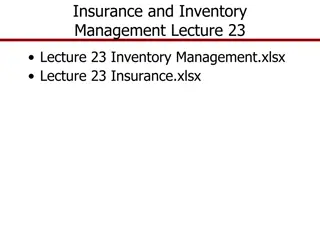Insights into Belgium's Federal Compulsory Health Care Insurance System
Delve into the historical background, organizational structure, financial aspects, and key characteristics of Belgium's compulsory health care insurance system. Explore the goals of the system, its evolution over time, and the initiatives aimed at ensuring accessibility, financial sustainability, and quality of health care services.
Download Presentation

Please find below an Image/Link to download the presentation.
The content on the website is provided AS IS for your information and personal use only. It may not be sold, licensed, or shared on other websites without obtaining consent from the author. Download presentation by click this link. If you encounter any issues during the download, it is possible that the publisher has removed the file from their server.
E N D
Presentation Transcript
Federal Compulsory Health Care Insurance in Belgium A kaleidoscopic view Chris SEGAERT NIHDI Dept. of health care International relations Workshop CBO, 1 October 2018
Content I. Introduction Historical overview Goals of the compulsory health care insurance II. Organisational structure & management III. Health care finance & expenditure IV. Compulsory health care insurance V. Conclusion : key characteristics 2
I. Introduction 3
Historical overview (1) 19th century: origins health insurance system with creation mutual benefit societies, e.g. voluntary sickness funds or mutualities 1894: sickness fund act beginning 20th century: creation of unions of health care funds according to political or ideological background 1944: introduction of the compulsory social security for salaried workers 1963: health insurance act & hospital act 1990: (new) sickness fund act 4
Historical overview (2) 1993: health insurance reform act (reform of the NIHDI management structure, introduction of stricter budgetary procedure and expenditure control, and measures to reinforce the financial responsibility of the care providers) 1994: reform of sickness funds (increased accountability of sickness funds for health expenditure) 1998: reform of eligibility of health insu 2002: hospital financing reform 2006: GP Impulseo fund I (special fund to support doctors to start up a practice in a region with a shortage of GPs) 1980, 1993, 2014: state reform with devolution of powers from federal level to the level of the federated entities 5
Goals of the Belgian health care system Increasing accessibility accessibility Increasing Maintaining financial sustainability sustainability Maintaining financial Assuring health care quality quality Assuring health care 6
II. Organisational structure & management 7
The Belgian health care system is mainly organised on two levels : federal compulsory health care insurance, financing of hospitals, registration of pharmaceuticals and their price control, determination of accreditation services (e.g. hospitals), federated entities health promotion, preventive health, elderly care, financing of hospitals, coordination and collaboration in primary health care and palliative care, implementation of accreditation standards and determination of additional accreditation criteria, 8
Actors on the federal Belgian level (1) FPS (Ministry) of Public Health, Food Chain Safety and Environment FPS (Ministry) of Social Security NIHDI KCE (Belgian health care knowledge centre) Health insurance funds ( mutualities ) Health care providers Insured persons / patients 9
Administrative organisation Regulation NIHDI : since 1963 federal public body agency endowed with legal personality accountable to the Minister of Social Affairs general organisation and (financial) management of the health care insurance, as well as implementation and control of regulations (benefits in kind and in cash) provides support during the consultation process budget 2018: 25.4 bio euro (benefits in kind) administration budget 2017: 111 mio euro ca. 1.156 (2017) 10
Administrative organisation Execution Health insurance funds ( mutualit s ) reimbursement to all insured persons negotiating prices and fees (collectively) information private not-for-profit list of health insurance funds compulsory health insurance vs, complementary health insurance 11
Administrative organisation Control Health insurance funds ( mutualit s ) NIHDI administrative control medical evaluation and control (reality/conformity and overconsumption) Supervising Authority of health insurance funds 12
III. Health care finance & expenditure 13
Health care financing social security contributions (through NSSO) government subsidies and taxes (VAT) external sources of funding, such as insurance companies pharmaceutical industry patient contributions (out-of-pocket payments) (private insurance) 14
Health care financing - flux Social Contributions FEDERAL LEVEL Public Health Social Affairs State contributions, taxes, VAT, National Office of Social Security Super- vision Regulation NIHDI transfers Services, regulation, supervision Mutualities 3rd party payer system Reimbursement Funds Direct payment Health care providers Insured people (patients) Services Health promotion Regulation SUB-FEDERAL LEVEL Communities and regions 15
IV. Compulsory health care insurance 16
Who is covered ? practically the whole population family based scheme conditions to be eligible : compulsory membership of health insurance fund payment of a minimum contribution (six-month waiting period) 17
What is the extent of the coverage ? both preventive and curative care required for maintaining and repairing a person's health medical care is divided in 25 different categories, the most important of which are ordinary medical care (GP, specialist, ), dental care, pharmaceutical products (pharmaceutical specialities, generic drugs, positive list), intervention for a hospital stay or for treatment in a health care institution, etc. excluded: esthetic care provisions that do not meet the reimbursement criteria 18
Fees & tariffs (1) fees fees for service or drug delivery fixed fees (per day, per admission) mixed fees base for reimbursement medicines and medical devices budgets activity based or per diem hospitals, day centers, rest homes, rehabilitation centres 19
Fees & tariffs (2) how are fees / tariffs established ? conventions (equal composition) agreement within a national joint commission approval by the management bodies and the Minister adhesion of a minimum amount of health care providers (60%) if no agreement: - reference tariff or - government tariff 20
The Belgian health care insurance provides a financial contribution to the costs, i.e. reimbursement system 21
How can patients obtain reimbursement ? standard procedure : reimbursement a posteriori special rule : third-party payer system compulsory for hospitals retail pharmacy 22
System of reimbursement fees doctor, dentist, physiotherapist, wheelchair, ... patients affiliation reimbursement = fee - PATIENT S CONTRIBUTION (out-of-pocket payments) health insurance funds 23
System of third party paying patient s contribution health care providers insured people/ patients health insurance funds 24
How are reimbursable benefits determined ? legal definition of the health care package nomenclature of medical services ( fee schedule) list of medicines qualifying for reimbursement the health care services which are reimbursed, their amounts and the conditions under which they are reimbursed are determined by the NIHDI in consultation with the various actors involved (health care providers, universities, health insurance funds), and confirmation by the management bodies and the minister (taking into account the budgetary limits) 25
What is the insurance contribution ? medical care: 75 % of the conventional fees pharmaceuticals: according to the category of the pharmaceutical cat A (severe and prolonged diseases) cat B (medicines useful from a social and medical point of view) cat C, Cs, Cx (medicines with a low therapeutic value) hospitalisation: fixed amount per admission + fixed amount per diem to be paid by the insured person (cost of stay, pharmaceuticals and clinical biology) 100% 75% 50% to 20% 26
What is the insurance contribution ? social corrections system BIM / OMNIO system of maximum billing (MAF) fixed payment systems (patients suffering from a chronic disease, incontinence material, ...) Special Solidarity Fund 27
V. Conclusion : key characteristics of the federal compulsory health care insurance 28
Key characteristics of the compulsory health care insurance (1) compulsory scheme with universal coverage (reimbursement system) => principle of solidarity and fairness free choice for patients and large offer of health care providers and services => principle of accessibility large benefit basket => principle of responsiveness state controlled, executed by private not for profit organisations => principle of subsidiarity 29
Key characteristics of the compulsory health care system (1) managed jointly by all stakeholders (management, consultation and agreements by and with social partners, health insurance funds and health care providers) => principle of responsible partnership pretty good score in terms of accessibility fee of the health care provider is mainly based on the medical service provided focus on the vertical organization (structure with compartments) rather than the horizontal approach (integrated care) 30
Thank you for your attention. Afbeeldingsresultaat voor tekening man met vraagtekens More information : www.riziv.fgov.be or www.inami.fgov.be ; or rir@riziv.fgov.be 31























